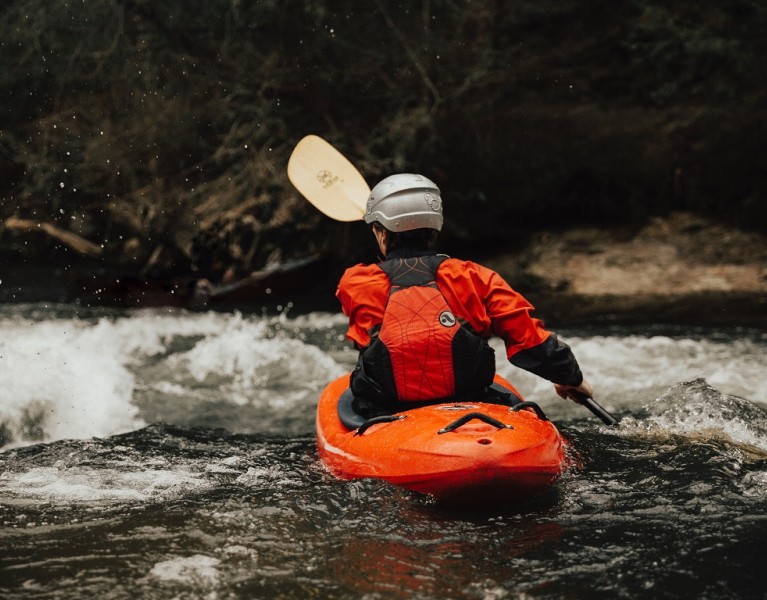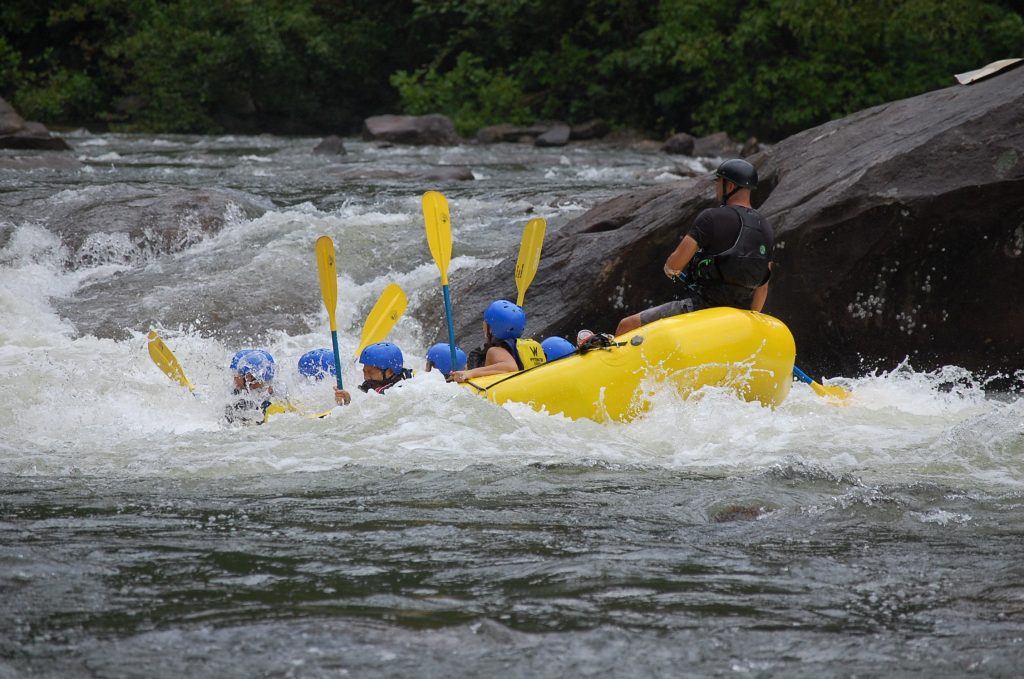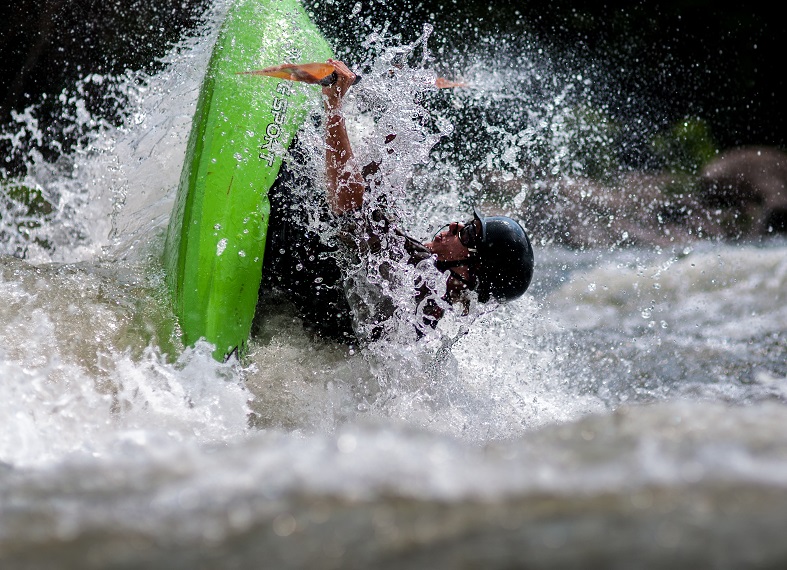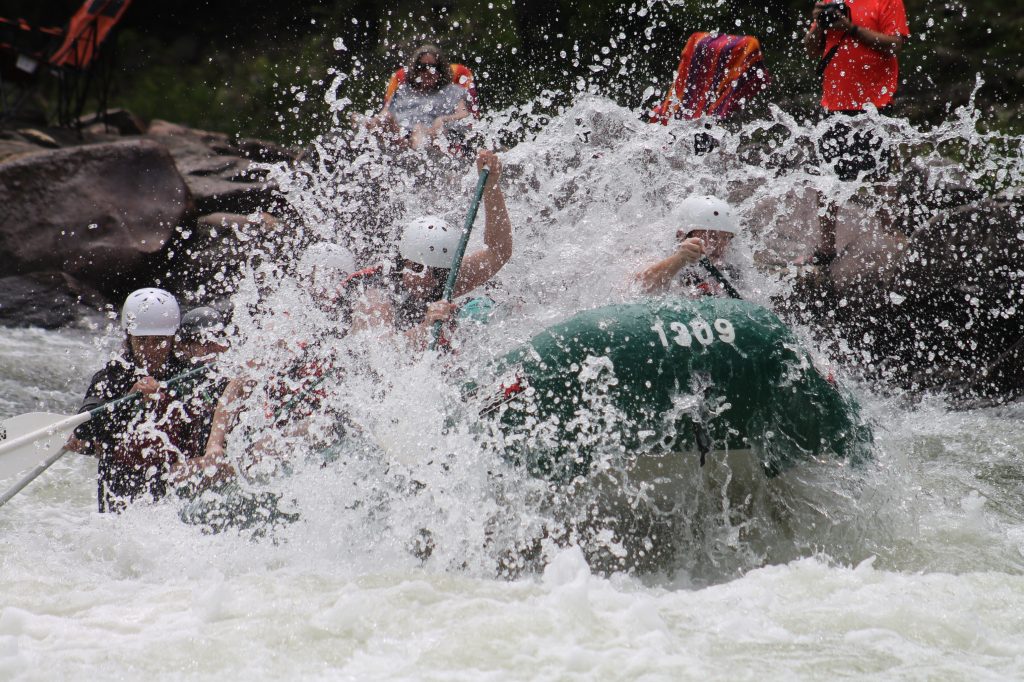- 1. Whitewater rafting glossary
- 2. The whitewater river classification system
- 2.1. Class I
- 2.2. Class II
- 2.3. Class III
- 2.4. Class IV
- 2.5. Class V
- 2.6. Class VI
- 3. Great rivers for rookie rafters
- 4. How to choose your river rafting guide
- 5. What to bring on your rafting trip
- 5.1. Tips for overnight trips:
- 6. Don't bail out on this bucket list item

Whitewater Rafting 101
Table of Contents [Show]
Meatgrinder. Satan's Cesspool. Deadman's Drop. Hospital Bar. If you've never been down the South Fork American River, the rapid names might send you to the nearest public golf course. Or, if you're like me, you'll be compelled to drop everything and start packing your camping gear for a road trip to Coloma, California. Don't let the names fool you, though. You're less likely to die on a commercially-guided whitewater rafting trip—assuming the statistics weed out the more death-defying rivers—than you would while bicycling or swimming (for fun... not from sharks). Most popular whitewater rivers will put you smack in the middle of gorgeous landscapes, and if you spring for a multi-day trip, you're in for an unforgettable, expedition-style camping experience.
Whitewater rafting glossary
Immerse yourself in the language on the Water by Nature site to better understand river rat chatter and terms necessary for crewing on a raft. Western River Expeditions has a fantastic visual guide to boat types and anatomy. For now, I'll cover a few terms, so you don't feel like you're up a creek:
Ducky: An inflatable kayak built specifically for whitewater.
Gear/oar boat: Operated by a single person manning two long rowing oars. The gear boat, reinforced with a tubular frame, carries everyone's gear and everything an expedition needs to set up camp.
Groover: A self-contained, compact portable toilet, usually carried on the gear boat. Ammo cans were the original groover, and the lines on one's tush caused by sitting on the can's metal rims inspired the nickname.
Hydrology/Hydraulics:Hydrology is the study of water's physical behavior, and river condition reports—including water levels and flow rates—are essential to safe paddling. In rafting terms, hydraulics is a general reference to a river's features, most specifically the shape and behavior of rapids, riffles, eddies, and holes. Do you want to know how to read the water? Go deep, or get a functional, rafting-specific hydrology overview.
Paddle raft: Paddlers sit on the sides while the guide steers from the stern (back).
Takeout: The spot on the river where the trip ends; rafts are pulled from the water; and everyone prays for the magical appearance of Chinese food.
Throw line: (Throw bag) You'll never find a rope on any type of boat, ever. There are only lines. In an emergency, you'll need to know what a throw line is, where to find it, and how to throw it. These lines are carefully packed into a football-sized sack and tossed to helpers on shore or in other boats when a raft becomes stuck.
Wrap: When a raft gets caught between rushing water and a large boulder, snag, or wall, it's become "wrapped." Often, the boat is smashed vertically against the obstacle, requiring assistance from people on shore to rescue the boat, and heckling from fellow guides at camp.

The whitewater river classification system
The International Scale of River Difficulty serves as the standard measurement to evaluate a river's difficulty. It takes into account hydraulics, obstacles, remoteness, and distance from emergency services. The class system, like the rivers they describe, is fluid. Rockfalls, bad weather, and flash floods are a few factors that can turn an easy float into a feral fiasco. Some rivers' official ratings vary according to scheduled dam release events.
Class I
These float rivers require little or no skill. They're great for inner tubes or sit-on-top kayaks. Aside from butt sharks, small snags or rocks that might goose you as you float by in your tube, the biggest danger is a bad sunburn.
Class II
You'll experience a few easy rapids and riffles, but you'd have to try pretty hard to get into trouble. Most beginners can self-guide if they have a good river map. If your kids want more action, stick them in duckies and wish them luck.
Class III
This is the sweet spot. You'll probably get a toned-down sampling of different types of obstacles, rapids, chutes, eddies, and drop pools. Self-guiding rafters will definitely need water-reading skills and, preferably, a few runs under their belt as paddlers before captaining their own boats.
Class IV
This is advanced-level paddling where your guide needs to be very familiar with the river, and paddlers should clearly understand and respond to instructions. On Class IV water, you've got to make sure the boat hits all its marks as it approaches and maneuvers through and around obstacles and hydraulics. In spite of this, it's not unusual for a family-friendly Class III river to sneak in a technically mild Class IV rapid or two, just for kicks.
Class V
Few commercial rafting companies operate on Class V water. Those that do generally set their standards pretty high when accepting clients. Long, grueling runs through dangerous water and sketchy geological features means paddlers must be in excellent physical condition and equipped to spend a lot of time in the water, pinballing against and over rocks.
Class VI
Here be dragons.

Great rivers for rookie rafters
These are the most popular whitewater rafting rivers for families and novices. If you want to explore other options, the Whitewater Guidebook is an excellent resource.
South Fork American River, California: Camp at Lotus Campground, and visit Sutter's Mill, ground zero for the 1949 Gold Rush. There's an upper and lower section, each perfect for a day trip. I've run this river at least a dozen times, and it never gets old.
Deschutes River, Oregon: The section from Harpham Flats to Sandy Beach is a fun Class III stretch with multi-day options that include a couple Class IV runs. Bring your flyfishing gear and maybe your climbing gear; Smith Rock State Park isn't far away.
San Juan River, Utah: You'll experience all sorts of wildlife, but off the water, the best part of this trip is the opportunity to explore the Anasazi petroglyphs and cliff dwellings. Each segment (Bluff to Mexican Hat, Mexican Hat to Lake Powell) is a multi-day trip. I rafted the former section in 1995 for a magazine assignment, and of all my adventures, that one is still my hands-down favorite. It's a mellow river—mostly Class I with some fun Class II riffles—but the scenery and history will have your heart in your throat. So will the scorpions, if you don't shake out your shoes before putting them on in the morning.
Middle Fork Flathead River, Montana: Paddle all the way from Bear Creek to West Glacier, or choose any one of three segments on this pristine wilderness river. Bring your hiking boots, fishing gear, and your camera. This Class II/III stretch between Bob Marshall Wilderness and Glacier National Park represents all the beauty you'd expect from the Treasure State.
Chattooga River Section 3, Georgia: Cue up Dueling Banjos! This is where Deliverance was filmed. Section Three of the Chattooga is a mostly Class II/III six-hour run with a Class IV surprise right before the take-out. By the way, the locals are actually quite nice.
Hudson River Gorge, New York: In the summer, when the flow levels are on the low side, the Upper Hudson Gorge is a Class III river, but when the water's raging in spring, so are the holes and rapids, kicking the river up to a solid Class IV. There are several excellent guide companies serving the area, and they can help you nail down the best times to plan a trip.
Lower Gauley River and Lower New River, West Virginia: I had to put something in here for those of you stuck between New York and Georgia, but I've got to warn you: the most famous whitewater rivers east of the Mississippi don't have kiddie pools. The Upper Gauley is for advanced experts only, but the Lower Gauley and Lower New Rivers—Class III+/IV—are do-able in the company of a good guide. Check out Summerville's Gauley Fest in late September; it's a huge paddling festival and conservation benefit with as much stuff to do on land as on the river.

How to choose your river rafting guide
Unless you're going with friends who have experience on your chosen river, it's a no-brainer that a guided trip is your best option. National, regional, and local outfitters operate on the most popular rivers, providing all the core equipment and personal flotation devices (PFDs). Most multi-day packages offer full-service amenities such as meals and packed lunches. I swear it wasn't just the hunger one gets from a whole day of paddling and swimming: some of the most delicious dinners I've ever had were served on the banks of the San Juan.
Guides can make or break your experience. All commercial operators should have training and backcountry first aid skills, but you can't teach attitude and personality. I used to raft with a multi-family private rafting club. My friend's dad was the "gonzo" boat captain who took every rapid balls to the wall, and then there was Uncle Bill:
"OK, hmm... Well, I think the safest thing to do would be to follow that line over there to the left..."
Which would send us into mutinous grumbles as we gently bypassed the fun stuff. But he was great with the younger kids, and made the best camp food, so we always forgave him for being the most boring river guide ever.
People are people, on and off the river. Commercial guides need the skills to deal with kids, whiners, and new rafters, and while they shouldn't be babysitters or Disneyland actors, their attitudes set the tone for your trip. When you're looking at reviews, find out which guides are the most popular. Tip them extra if they did a great job, and don't forget your shuttle driver!
What to bring on your rafting trip
Most multi-day whitewater trips provide detailed planning guides and packing tips, but if you're going for a half-day or daylong trip, you might not get much advance information. These are must-have core items you'll find on any guide-specific packing list:
- River shoes: REI always has a good selection of grippy water shoes, and the river guide's standard water sandal brand: Chacos!
- Quick-drying shorts or water-resistant pants: Find a comfy pair that won't chafe, or that won't fall off when you're being pulled out of the water.
- Sun-blocking long-sleeved shirt: Protect yourself from sunburn!
- Hat: Buy a broad-rimmed hat with a breakway chin strap, or retrofit your favorite floppy headwear with a safety clasp.
- Large dry bag: For overnight trips, choose a bag big enough for all your gear and then some.
- Small dry bag/pouch: Where you'll stash your snacks, sunscreen, and camera so it's easily accessible.
- Medium dry bag: Pack your lunch, fleece sweater, and comfy plants. You'll want warm clothes for late-afternoon takeouts.
- Water container: Bring a non-disposable water bottle with a sturdy attachment point. You'll get thirsty, and the river might not be safe for drinking.
- Small microfiber towel: Keep it in your small day bag so you can clean off your sunglasses and tech should they get splashed.
- Carabiners: Attach your water bottle and day-use dry bags to the raft with a trusty 'biner.
Tips for overnight trips:
Riverside camping is usually limited and tightly regulated, which means you'll probably be sleeping on hard-packed ground, river rocks, or sand. Pack a really good sleeping pad, or ask if hammocks are a practical option.
Pro tip: Strip the cardboard off your favorite box wine if you're trying to save space. Don't drink on the river or at lunch. Do drink at the end of the day. Bring enough to share!
Bring biodegradable toilet paper for the groover or on-site pit toilets, and plastic baggies or odor-locking bags for personal hygiene products. Leave No Trace is a big deal on rivers, especially those that wind through protected areas or reservation land. Obviously, you'll want to bring the other stuff you'd take with you on any camping trip. Like your toothbrush. And lots of extra underwear. Just be sure to adhere to baggage limits set forth by your guide.
Don't bail out on this bucket list item
Have I convinced you to cancel your annual trip to the water park? You can't leave this mortal coil without engaging in an epic Super Soaker battle with enemy armadas, or swimming down a Class II rapid Bear Grylls-style. Whitewater rafting is the gateway to adventure sports, and once you've shot your first rapid, you're all in. Featured image by roya ann miller.


